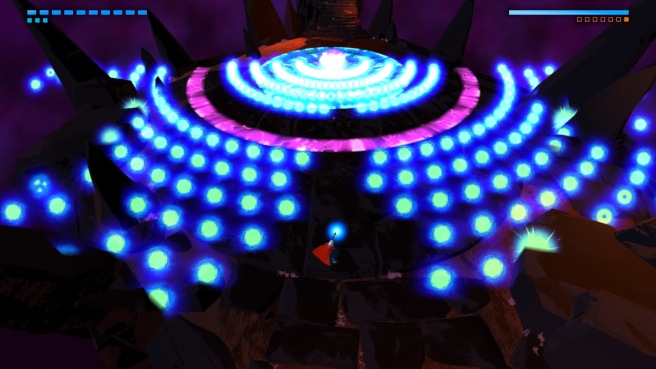There’s something beautiful about a game that you can play and beat in an afternoon. It’s so very refreshing in this era of huge, expansive 100-hour experiences. Furi lasted me a scant few hours one quiet afternoon but in that short time I played a tightly-constructed and fantastically intense game that was an instant hit for me.
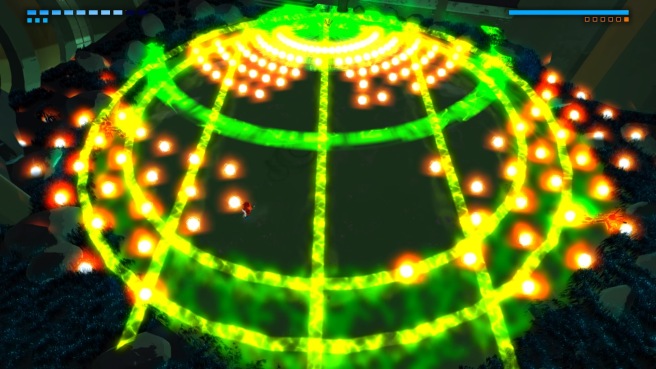
Furi (PC, PS4 [reviewed], Switch, Xbox One)
Released Jul 2016 | Developed / Published: The Game Bakers
Genre: Hack and slash, Shoot ’em up | HLTB: 6 hours
We begin with a being known to us only as the Stranger. They’ve been imprisoned in a multi-leveled prison of micro-planets, suspended in sequence above a planet – yes, you get a big look at it in the opening, and yes it looks exactly as cool as it sounds. It wouldn’t be much of a game if you were just a prisoner though, and so we start by escaping, accompanied by a mysterious teleporting rabbit-headed being known only as the Voice. The only way out is through his jailers, nine bosses who have each dedicated their lives purely to stopping the Stranger ever breaking free of his bonds and reaching the world below. The barebones story is filled in by cryptic narration, both from the Voice between fights and from the bosses themselves, though they never offer much, just to keep you guessing.
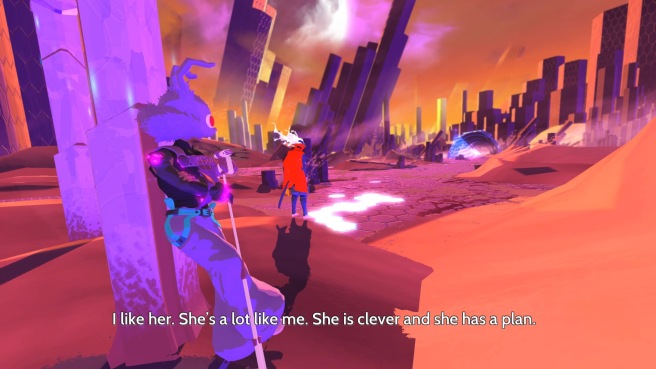
Furi is a boss rush game – there are no fights other than those against your jailers. You only get a handful of mechanics to work with in your fights – the Stranger can fire his automatic laser pistol, slash with his sword, dodge, and parry, and that’s it; defeating each boss is a lengthy puzzle of working out how to avoid their attacks in order to get in and start chipping away at their health. It’s practically a rhythm game at its best, with a stupendous sense of flow as you observe attack patterns, figure out ways to find or force an opening, and then dash in and inflict some serious damage on your captors. It’s part hack-and-slash and part bullet hell; bosses can unleash a wild barrage of laser blasts that bring to mind Touhou and Gradius as you maneuver in the tiny spaces between them before getting in close and reading the patterns of melee attacks, parrying in the fractions of seconds you get to knock your foes off balance. The feeling of power as you fall into rhythm is – in a word – exceptional.
Each fight is approached in phases. Every boss has a series of stages (the least is 3 but the most is significantly more), and in each stage they change up their attacks and exhibit new patterns. Though each is broadly similar from phase to phase, each new step of the fight is a brand new challenge as you try to adapt as quickly as possible to your opponent’s new attacks. In the game’s standard difficulty it’s bad enough, but taking on the unlockable Furier mode requires real dedication and lightning-quick reflexes. I admit to being a big fan of the game’s life system; just as bosses have a set of phases that represent how close they are to defeat, the Stranger has his own life pips. When you lose all your life, you can pick yourself back up and the current phase begins anew; should you lose all your pips, it’s game over and you’ll have to start the fight again, though finishing a phase lets you recover a life pip. It’s a good system which can keep you on the edge of your seat as you’re given multiple chances to figure out that phase of attacks, but you take damage quickly and a moment of lost concentration can be fatal.
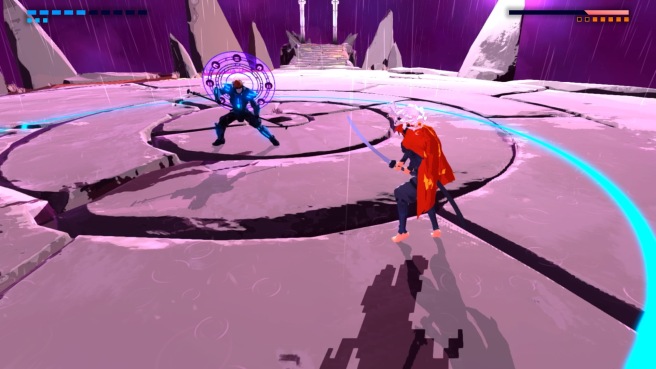
There’s a pleasing and surprising variety in bosses. Given each fight has fundamentally the same core pattern of learning attacks, learning timings, and finding gaps, it’s brilliant to see how different one jailer can be from another. Some bosses embrace wildly erratic movements that make them difficult to track, even to the point of needing to watch the arena for clues as to where they are or will be, while others take on the Stranger on an equal, stolid footing. Some prefer to keep their distance from the Stranger, forcing you to plink away with your gun while trying to lure them closer, or even dealing with fights and phases that never let you close in for a melee round. Others still are all but wholly built around close combat; one of my favourite fights even has a round that forces the camera around into a 2D one-on-one fighter perspective, and the difference it makes to your ability to read events is a quick shock.
I mentioned that the game can be challenging and indeed it is. During my time writing this review I’ve seen a fair bit of discussion online about Furi’s difficulty, including a notable Kotaku article. I do appreciate the discourse, and think difficulty and fairness is a good argument to have; in times past (even on an old, long-dead blog from my younger days) I’ve talked before about the profusion of games that are hard for the sake of it, and how many games struggle to find that fine balance between hard-but-fair and frustrating. For my own two cents though, I’d say Furi handles its difficulty very well – every attack is telegraphed, and there is always ample opportunity not just to dodge or parry attacks, but also to reply with your own. It is however, worth acknowledging that it is very reflex-intensive, and I can easily see some struggling with that; it’s not exactly an accessible game because of it. It does have an easier difficulty called Promenade, but annoyingly Furi is one of those games that embraces chastising its player base for picking it – I am always of the opinion that if you as a developer make the conscious decision to include an easy mode in your game but make fun of the player for doing so, then you’re simply being malicious at worst, and a prick at best so don’t bother having it at all.
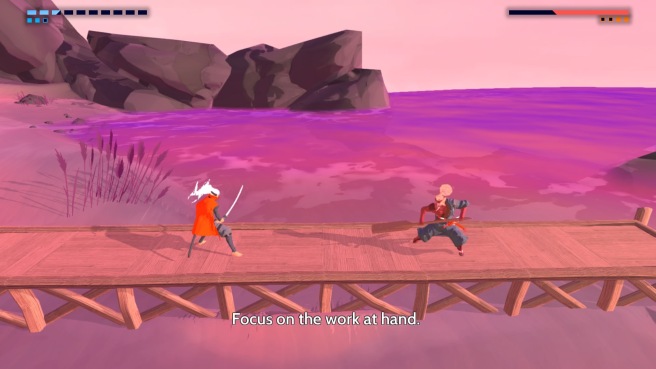
One might question if a game like this has any real sense of replayability; it was certainly a question that I pondered before going in, and again once finishing it for the first time. On the surface might not look like it has a lot beyond a harder difficulty mode and some bonus bosses but then again I booted it up the day after and replayed it just to see if I could get better and finish fights with less damage so there you go. That drive to improve oneself is a potent motivator, and games like Furi expertly tap into it; sure I beat the game, but surely I can do even better, with less hits taken, or more stylishly?
Furi does at least have a dedicated mode to challenge and practice specific stages of bosses you’ve already beaten; however, it was added in a later patch, and nothing seems to point towards it in-game, which is a shame. For a game built around its boss fights, and even with an inbuilt speedrun mode, you’d think being able to hone your skills against a particularly difficult bit might be a priority to point players towards, but apparently not.
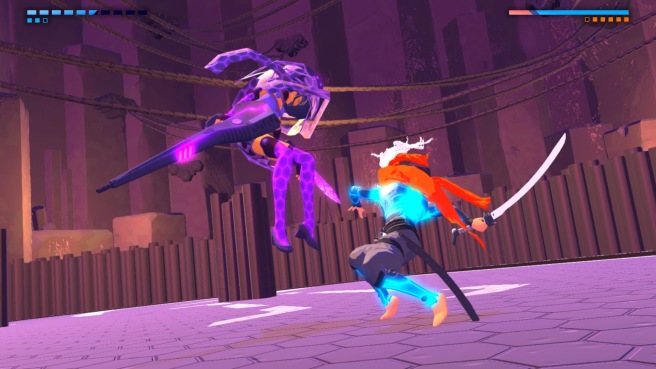
One aspect that helped me with replayability is its utterly stunning aesthetic. I’m a great lover of sci-fi, and Furi delivers there; it’s all cyberpunk neons and machinery! Each individual micro-world has its own design and its own characteristics. Descending from his prison the Stranger sees such weird wonders as a complex and layered prison-within-a-prison where the walls constantly regrow to confound anyone in there, to a twisting Escher-esque landscape with floating monoliths and paths that twist upside-down. Fighting the bosses again and again has its own merit and is its own reward, but constantly going back and immersing myself in the world of Furi never got old.
The cyberpunk feel extends to the music. Furi features a mesmerising soundtrack, which was jointly composed, with an array of artists each submitting tracks. Danger’s 6:24 sets the tone perfectly: a filthy, fuzzy synth bass, a powerful pulsing drum beat, gorgeous shaking synthwave, and the constant glitchy breaks are so marvelous as they jump and twist the track into something more than the sum of its parts. It emulates the feel of the boss progressing through phases, almost as if the music is being interrupted by the sword strokes of the Stranger, a notion which persists along all of the submitted tracks. Those synths and reverberating drums always scream the 80s, and they’re applied liberally here, but always alongside production techniques and song construction that feels modern in some ineffable way. Waveshaper’s Wisdom of Rage adds in wobbling vocoder lines, powerfully exciting stabs and even rapid 8-bit glissandos to capture the shifting time control in one particular boss fight to stunning effect.
Lorn’s contributions, Unraveled and Set Me Free, are both notable standouts from the soundtrack; the former uses a distorted beat and a wailing, lethargic ambience to match the feeling of the destroyed, sunken city that one of the Stranger’s jailors inhabits, while the latter uses a superb tape-delay and filter to force its melody back behind the oppressive drums. Really the temptation is here to simply link everything, such is the strength of this soundtrack. Do yourself a favour and go listen to it here.
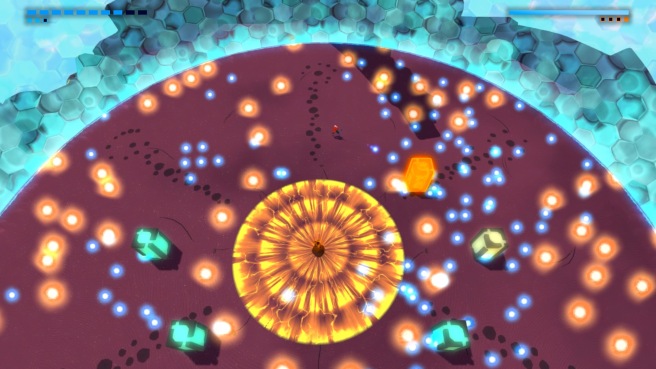
In short, Furi was excellent. I’m not wild on bullet-hell as a genre, or even as a subgenre within games, and I don’t typically play games to be challenged – I’m a narrative lover first and foremost and I make no apologies for it, and yet despite all that Furi engaged me in a way few games have in a long time. It’s an instant, grab-you-by-the-throat kind of feel; chuck in the seriously brilliant soundtrack and those phenomenal visuals and I was hooked, and that’s even before the fast-paced gameplay forced me to sit up and pay attention.
6/7 – EXCELLENT.
Games with a touch of brilliance. It might only just miss out on being an absolute favourite, but you should definitely play this.